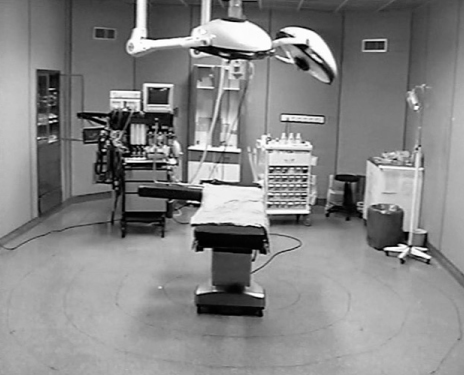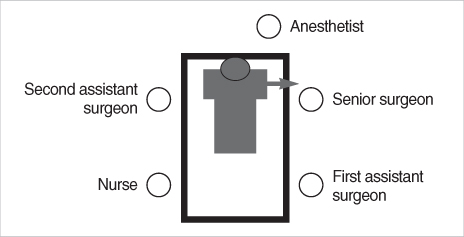J Breast Cancer.
2009 Mar;12(1):27-31. 10.4048/jbc.2009.12.1.27.
Exposure of Surgical Staff to Radiation During Surgical Probe Applications in Breast Cancer
- Affiliations
-
- 1Department of Nuclear Medicine, Dokuz Eylul University School of Medicine, Izmir, Turkey. recep.bekis@deu.edu.tr
- 2Department of Surgery, Dokuz Eylul University School of Medicine, Izmir, Turkey.
- KMID: 2286575
- DOI: http://doi.org/10.4048/jbc.2009.12.1.27
Abstract
-
PURPOSE: The aim of study was to determine the level of the radiation exposure of surgical staff during surgical probe applications in breast cancer.
METHODS
Three operations of a sentinel lymph node biopsy were randomly selected. Spaced circles (50 cm apart) were drawn surrounding the operation bed on the floor. Tc-99m nanocolloid was injected peritumorally and intradermally into a patient. The radiation dose was measured with a GeigerMueller counter placed according to the drawn circles at distances of 50-200 cm from the side of patient's head and bilateral chest while the patient lay on the operation bed. All of the surgical procedures were recorded with a video camera and were monitored.
RESULTS
The whole body dose to the senior surgeon was calculated as 2.00-4.70 microSv which means that a senior surgeon can perform 212-500 procedures per year to reach the annual International Commission on Radiological Protection radiation dose limit for a member of the public.
CONCLUSION
We concluded that radiation risk to the surgical staff is low from sentinel node detection with the use of radiocolloids.
MeSH Terms
Figure
Cited by 1 articles
-
Radiation Safety Issues Related to Sentinel Lymph Node Biopsy using Radioactive Colloid: Commentary on "Exposure of Surgical Staff to Radiation"
Mijin Yun, Arthur Cho
J Breast Cancer. 2009;12(2):121-122. doi: 10.4048/jbc.2009.12.2.121.
Reference
-
1. Ivens D, Hoe AL, Podd TJ, Hamilton CR, Taylor I, Royle GT. Assessment of morbidity from complete axillary dissection. Br J Cancer. 1992. 66:136–138.
Article2. Maffioli L, Sturm E, Roselli M, Fontanelli R, Pauwels E, Bombardieri E. State of the art of sentinel node biopsy in oncology. Tumori. 2000. 86:263–272.
Article3. Sandrucci S, Casalegno PS, Percivale P, Mistrangelo M, Bombardieri E, Bertoglio S. Sentinel lymph node mapping and biopsy for breast cancer: a review of the literature relative to 4791 procedures. Tumori. 1999. 85:425–434.
Article4. Keshtgar MR, Ell PJ. Sentinel lymph node detection and imaging. Eur J Nucl Med. 1999. 26:57–67.
Article5. Sacks NP, Baum M. Primary management of carcinoma of the breast. Lancet. 1993. 342:402–408.
Article6. Bombardieri E, Crippa F, Maffioli L, Draisma A, Chiti A, Agresti R, et al. Nuclear medicine approaches for detection of axillary lymph node metastases. Q J Nucl Med. 1998. 42:54–65.7. Wilson MA. Textbook of nuclear medicine. 1998. Philadelphia: Lippincott-Raven;396.8. International Commission on Radiological Protection. 1990 recommendations of the Internataional Commission on Radiological Protection. 1990. Oxford: Pergamon Press.9. Stratmann SL, McCarty TM, Kuhn JA. Radiation safety with breast sentinel node biopsy. Am J Surg. 1999. 178:454–457.
Article10. Waddington WA, Keshtgar MR, Taylor I, Lakhani SR, Short MD, Ell PJ. Radiation safety of the sentinel lymph node technique in breast cancer. Eur J Nucl Med. 2000. 27:377–391.
Article11. Cremonesi M, Ferrari M, Sacco E, Rossi A, De Cicco C, Leonardi L, et al. Radiation protection in radioguided surgery of breast cancer. Nucl Med Commun. 1999. 20:919–924.
Article12. Eshima D, Fauconnier T, Eshima L, Thornback JR. Radiopharmaceuticals for lymphoscintigraphy: including dosimetry and radiation considerations. Semin Nucl Med. 2000. 30:25–32.
Article13. Miner TJ, Shriver CD, Flicek PR, Miner FC, Jaques DP, Maniscalco-Theberge ME, et al. Guidelines for the safe use of radioactive materials during localization and resection of the sentinel lymph node. Ann Surg Oncol. 1999. 6:75–82.
Article14. Brenner W, Ostertag H, Peppert E, Czech N, Kampen WU, Muhle C, et al. Radiation exposure to the personnel in the operating room and in the pathology due to SLN detection with Tc-99m-nanocolloid in breast cancer patients. Nuklearmedizin. 2000. 39:142–145.
Article15. de Kanter AY, Arends PP, Eggermont AM, Wiggers T. Radiation protection for the sentinel node procedure in breast cancer. Eur J Surg Oncol. 2003. 29:396–399.
Article16. Morton R, Horton PW, Peet DJ, Kissin MW. Quantitative assessment of the radiation hazards and risks in sentinel node procedures. Br J Radiol. 2003. 76:117–122.
Article
- Full Text Links
- Actions
-
Cited
- CITED
-
- Close
- Share
- Similar articles
-
- Radiation Safety Issues Related to Sentinel Lymph Node Biopsy using Radioactive Colloid: Commentary on "Exposure of Surgical Staff to Radiation"
- Researches of Epigenetic Epidemiology for Infections and Radiation as Carcinogen
- Three Cases of Elderly Women with Breast Cancer treated with Non-operative Methods
- Are Medical Personnel Safe from Radiation Exposure from Patient Receiving Radioiodine Ablation Therapy?
- Breast-Conserving Surgery With or Without Radiation Therapy for Early Breast Cancer



